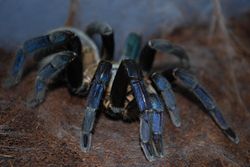The Cobalt blue tarantula has a leg span of 4-5 inches and has 2.5 inch wide body. [2] It has a cephalothorax and an abdomen as their two body parts. The Cephalothorax is usually the thorax or chest and a head. It has eight eyes closely attached to each other and a lot of hair.[3] People get scared of the Cobalt blue a lot because it comes with the title of 'tarantula' but they're harmless to humans, the venom is less harmful than a bee's venom. They get used as pets a lot. Tarantulas shed their exoskeleton in the process of molting, in which they change most of the organs as wells. [4]
They might appear like dark brown or black at first but in proper lighting their color appear as blue throughout their body. Females look better and larger than males and usually live longer than them. When they molt they usually get on their back. Its color changes and bone gets pale and soft. By its color and texture other species or people have to stay away from it so they can finish their molting process successfully.[5]
The Cobalt blue tarantula (female) lives almost 2 times longer than male. After a male matures they can only live for two to three months which would be 10 to 12 years. Females generally live 20 to 24 years.[3] Cobalt blue tarantula reproduce sexually. The male approaches the female carefully. There might be a chance for a male to get bitten or killed by the female depending on the temperature and the mood that female's in. They show ritual by tapping to charm females.[6]
Females lay 100 to 1000 eggs, which hatch in 45 to 60 days in a web. The females do all the jobs such as, protecting the eggs. If they have the egg sac they might stay with their parents for 3 to 6 days before they disperse. A large amount of premature spiders get caught by predators and end up getting eaten.[4] Tarantulas don't hunt their prey by webbing them, they have webs that alert them so they can go grab the prey with its appendages. Then they paralyze the victim with their paralyzing venom. After that, they liquefy the victim with digestive enzymes so they can suck it up with their straw like mouth. After a huge meal, tarantulas can go without eating for as long as a month.[4]
Cobalt blue tarantula generally live in southern Asian areas like Myanmar, Thailand, Laos, Cambodia, and Vietnam. They are native to these countries, but people from all over the world like to buy this tarantula as pets because they're harmless. They also find this tarantula fascinating especially by the way it eats. Tarantula live wherever there's soil so they can burrow and wait for their prey. They take hours to make this hole that they can hide in and wait for their prey to come in a secure area where they can get the prey for sure. The hole they hide fits more than its body, which tells that they spend lots of time digging this hole. Once they're done with making this hole, they can settle there as long as they want.[7]
The region Cobalt blue live is a rain forest where it's really hot but full of moisture. They have their soil wet and in order for them to reproduce they need an environment just like where they live. The temperature of the forest is really hot, approximately 68 degrees Fahrenheit to 77 degrees. They don't hunt during the day but approach their prey during the night. They rush out of the hole when they attempt to capture the prey but some times, when its hard to catch they make a small trap with their web to slow them down temporarily and then catch them.[8]
Cobalt blue tarantula's are used as pets a lot. People like to watch how they catch prey from a hole they dug. They have to take care of their tarantula with organic soils and watch the temperature. Because they are from the tropical region, they need hot temperature so people put hot pack in the bottom of their shelter. [9] They feed their tarantulas when it's dark because they hunt during night time. They feed them live crickets to keep their habits of hunting. For reproduction, they have to take extra care with the environment they have because they won't reproduce if everything's not perfect. [8]
A video of Cobalt blue tarantula attacking a sling and eating it. It tells that Cobalt blue tarantula is very fast and doesn't approach its target unless it's in a perfect condition for them to attack.
| Cobalt blue tarantula |
|---|
 |
| Scientific Classification |
|
| Binomial Name |
Haplopelma lividum |
|
||||||||||||||||||||